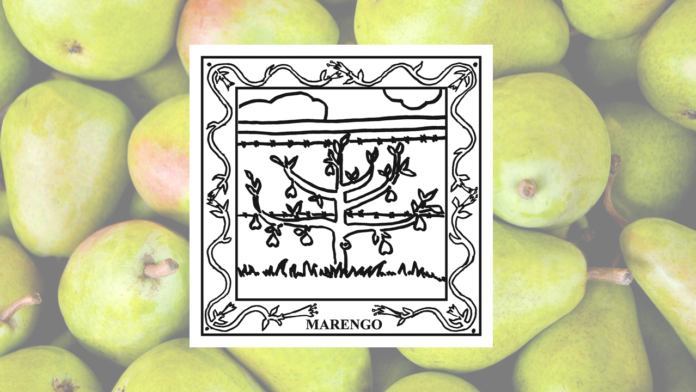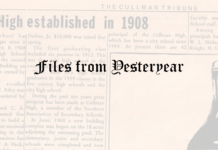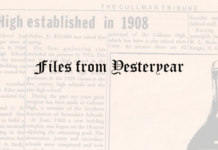The Cullman Tribune is celebrating the Alabama Bicentennial (1819-2019) with statewide field reporting by Alabama Master Gardener/Botanical Artist Ben Johnson South. This year-long feature, “The 67-County Alabama Garden Party,” will spotlight different counties each week. Each county will get its own “quilt block,” along with a historical profile, and we’ll share a recipe specific to the area. At the end of the year, all 67 counties will be put in a book to commemorate the Bicentennial.
Marengo County
Ooh La, La, y’all! Welcome to Marengo County, originally established as a French wine and olive colony. The Bonapartists founders named this Alabama county to celebrate The Battle of Marengo, where Napoleon defeated the Austrians. The county seat is Linden named for another Napoleonic victory. (Note: Alabama has a place named Waterloo, but it is several counties away in much less French-rooted terrain.)
Marengo County did not prove to be a compatible place for Bordeaux or champagne vineyards, but Alabama gardeners have embraced many French jardin techniques over the past 200 years. Here are ways Marengo County encourages us to add panache where PLANTS + PEOPLE, or “les plantes + les gens” come together:
*PUT A MEASURING TAPE IN YOUR GARDEN SHED- French plantings are exactingly designed and deliberate; nothing is left to chance. Even when something appears to be spontaneous, it is not. Imagine a perfectly spaced allee of native, Alabama pecan trees punctuating your driveway.
*CONTROL NATURE ABSOLUTELY- Remind the trees and everything in your landscape that you are in charge at least until the next Alabama tornado or drought; edge like an engineer, prune like a Parisian Edward Scissorhands.
*CREATE A FOCAL POINT TO BE SEEN FROM YOUR CHATEAU- Whether it’s a window box or a grand fountain, plan for something outside to engage your eye when viewed from inside your home.
*GEOMETRY AND SYMMETRY RULE THE DAY- Here’s where I get to “place drop” that when I was working with perfumers in Grasse and Paris, France, I was given a private tour of the grand palace and gardens at Versailles. Most of us, unlike Louis XIV, don’t have an André Le Nôtre-caliber landscape architect, but we can still enjoy the pleasure of mirror-image, precisely square or precisely-some-shape planting beds.
*ALLOW FOR SOME WONKY GARDEN ELEMENT TO EASE THE FRENCH FUSSINESS- Picture an array of precise walks and designed spaces and then muster some Coco Chanel audacity to surprise with an asymmetrical corkscrew willow or some contemporary outdoor sculpture.
*TOPIARY TRIUMPHS- “We want candy,” like the pop song says in the 2006 Cannes-awarded film, “Marie Antoinette,” and in our French-influenced jardin we want lollipop-shaped yew and rosemary topiaries. (Shameless plug: a classical ballet based on my children’s story, “The Reluctant Topiary,” is being choreographed by Brooke Desnoes, who owned a ballet school in Paris for years; the premiere is spring 2020; consider yourself invited to that garden party!)
*METAL AND PETAL- Enjoy the exquisite contrast of soft plants against hard metal; the French do this with wrought iron garden furniture, zinc planters and even tin watering cans.
*MIRROR SOMETHING OUTSIDE- The famed “Hall of Mirrors” at Versailles is 34 feet high, 240 feet long and created for jaw-dropping awe; you may not want to be that outrageous, but some reflective surface like a fish pond or a birdbath will add a bit of romance and magic (la magie).
*ESPALIER A PEAR (POIRE) OR APPLE (POMME) TREE- Espalier is an exotic word for us Alabamians, but it’s a smart, time-tested and relatively simple gardening technique perfectly attuned to smaller spaces. As the one I drew in the “quilt block” for Marengo County, fruit trees have been espaliered for centuries, affixed to sun-warm garden walls. Though not yet verified with Alabama Archives, I’m willing to bet a few francs that the French settlers in early Demopolis and Linden espaliered some of their Alabama fruit trees.
Here are other pleasurable and positive ways PLANTS +PEOPLE intersect in Marengo County:
*MARENGO COUNTY FARMERS MARKET- Demopolis Tractor Supply Company Farmers Market, 1404 U.S. Highway 80 West, Saturdays, May-September; Thomaston Farmers Market, intersection of Highway 25 and Highway 28, summer months; Bobby Jones (Dixon Mills) 8972 County Road 55
*MARENGO COUNTY STILL HAS A VINEYARD IN VINELAND- Autry Vineyards in the apt-named Vineland community offers organic muscadines for u-pick, buckets provided, Sept 1- Oct 15, 7 days a week.
*ALFALFA, ALABAMA- Say that three times fast- is a Marengo County place with a plant name, as are: Half Acre, Magnolia and the aforementioned Vineland; plant tourists welcomed.
*B’NAI JESHURUN SYNAGOGUE- An 1858 wooden structure built of local pine and created in the Moorish Revival style with a domed top served as a temple in Marengo County, Alabama’s fourth-largest Jewish settlement; most of Alabama’s rural Jewish population migrated to the bigger cities in the late 19th century and early 20th century. This worship house was sold to the Episcopal church after Jewish artifacts were donated to the Museum of Southern Jewish Experience (Jackson, MS).
*GAINESWOOD PLANTATION- Completed in 1861 after 20 years of construction and considered one of the most beautiful neoclassical structures in America, Gaineswood is now in the city of Demopolis, but was once the main house of a sprawling and extremely lucrative cotton plantation built mostly on slave labor. The walled Gaineswood gardens, featuring an impressive columned pavilion, highlight French-flavored exactitude with geometric planting beds outlined by clipped parterres.
*CHICKASAW STATE PARK- This 520-acre ramblin, roadside park has belonged to the State of Alabama since 1819 and was developed as parkland by the Civilian Conservation Corps in the 1930s- perfect for picnicking, hiking and a popular perch on the Alabama Black Belt Birding Trail. Contiguous with this park is the Turnipseed-Ikenberry Place Physically Disabled Hunting Area, also operated by the state.
*PLANT AN IDEA- Alabama has loved magnolia trees since Marengo County was a wine colony. How about building a small garden party space in downtown Demopolis by constructing easy-but-sturdy trellising (the French say “treillage”) for three sides and espaliering a magnolia tree on each to create three “living walls” for an inexpensive, public-inviting outdoor room? Versailles planters made of local timber could be planted with Marengo County French blue hydrangea.
Y’ALL COME to Marengo County on your 67-County, Alabama Garden Party tour! As the French settlers used to write home about the natural beauty here, “Marengo c’est magnifique!”
MARENGO COUNTY MICROWAVE PEAR PEPPER JELLY
This recipe was inspired by the Pepper Jelly Festival in Thomaston. It’s an elegant use of locally grown peppers and the pears from your espaliered pear tree. Pear pepper jelly would make a delicious, gluten-free, vegan condiment for the Candlelight Evening at Gaineswood or picnicking at Christmas on the River.
INGREDIENTS
- 1 ½ cups cider vinegar
- 4 Marengo County jalapeno peppers
- 2 Marengo County red bell peppers
- 3 Marengo County pears
- ½ cup sugar
- 6 oz. pectin
DIRECTIONS
- Finely chop bell and jalapeno peppers (include stems, seeds, ribs for more heat) and pears.
- In a 3-quart microwave casserole dish, combine all other ingredients with the chopped pears and peppers, EXCEPT the pectin.
- Cook uncovered on high for 8-12 minutes to a full boil; stir well to make sure sugar is dissolved.
- Stir in pectin. Cook on high for 1-3 minutes to a full boil.
- Stir well and spoon into sterilized gift-sized jars. Cover tightly with sterilized lids and rings. Store in refrigerator up to 4 months.
Also, check out Alabama Bicentennial: 200 ways to save Alabama for the next 200 years.
Copyright 2019 Humble Roots, LLC. All Rights Reserved.
























